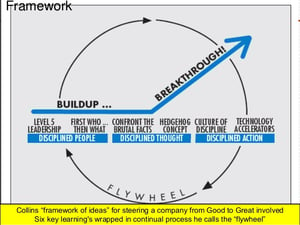 Do you believe in Good to Great as the pattern to build a Great Company?
Do you believe in Good to Great as the pattern to build a Great Company?
In Collins’ Turning the Flywheel: A Monograph to Accompany Good to Great, he feels the verdict of history is clear on what makes great companies tick!
Big winners take their flywheel from ten turns to a billion turns. As opposed to companies who crank through ten turns, then decide to start over with a new flywheel. They push that flywheel to ten turns, and again divert energy to yet another new flywheel.
Collins recommends, “When you reach a hundred turns on a flywheel, go for a thousand turns, then ten thousand, then a million, then ten million, and keep going. Apply your creativity and discipline to each and every turn with as much intensity as when you cranked out your first turns on the flywheel, nonstop, relentlessly, ever building momentum. If you do this, your organization will be much more likely to stay out of How the Mighty Fall and earn a place amongst those rare few that not only make the leap from good to great but also sustain it to become built to last.”
Collins shares the formula for crafting your Flywheel.
What follows is a shorten version from the book, with my personal comments.
Create Your Flywheel
Here's Collins’ six-step process developed and refined in Good to Great® Dialogue sessions with executive teams.
- Create a list of replicable successes your enterprise has achieved.
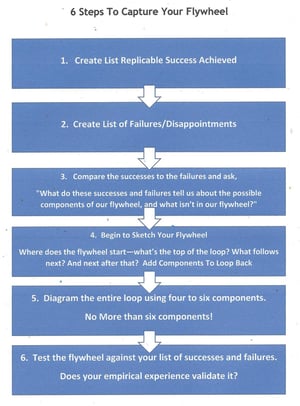 Variations on an essential idea count as replicable successes; for example, Vanguard created a plethora of low-cost mutual funds (variations), all consistent with the underlying flywheel. (This is more difficult than it might sound. You may want to pick up The Thin Book of Appreciative Inquiry by Sue Annis Hammond to help with this process.)
Variations on an essential idea count as replicable successes; for example, Vanguard created a plethora of low-cost mutual funds (variations), all consistent with the underlying flywheel. (This is more difficult than it might sound. You may want to pick up The Thin Book of Appreciative Inquiry by Sue Annis Hammond to help with this process.) - Compile a list of failures and disappointments. This should include new initiatives and offerings by your enterprise that failed outright or fell far below expectations. (Believe it or not this is easier, although in some cases it can be more difficult if you tend to want to forget when you failed. In most cases we learn more from failure than we do from success.)
- Compare the successes to the failures and ask, "What do these successes and failures tell us about the possible components of our flywheel, and what isn’t in our flywheel?" (Remember what we as humans are best at? Pattern recognition. What’s common with your failures, and what’s common with your successes?)
- Using the components you’ve identified, sketch the flywheel. Where does the flywheel start—what’s the top of the loop? What follows next? And next after that? Each component of the flywheel should feed into the next stage of the flywheel. Outline the path back to the top of the loop and be able to explain why this loop cycles back upon itself to accelerate momentum in your particular context. (Expect a good deal of debate and discussion. Vanguard spent 2 days with Collins in Colorado hammering theirs out, and Amazon took a great deal of time to make sure their Flywheel was correct.)
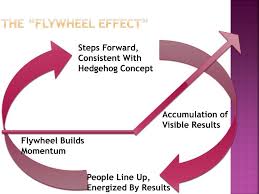 Diagram the entire loop using four to six components. If you have more than six components, you’re making it too complicated; consolidate and simplify the model to capture the essence of your flywheel. (The examples in the book, and those I shared from Amazon, and Ware Elementary, will be helpful to understand)
Diagram the entire loop using four to six components. If you have more than six components, you’re making it too complicated; consolidate and simplify the model to capture the essence of your flywheel. (The examples in the book, and those I shared from Amazon, and Ware Elementary, will be helpful to understand) - Test the flywheel against your list of successes and failures. Does your empirical experience validate it? Tweak the diagram until you can explain your biggest replicable successes as outcomes arising directly from the flywheel and your biggest disappointments as failures to execute or adhere to the flywheel. (There’s no better way to determine whether you have your flywheel accurate, then to test it against your successes and failures.)
One of my former customers achieved great success as he discovered and applied the principles of Good to Great. Collins shares a Map in the Appendix on how all the pieces of Good to Great fit together, including the Flywheel. It’s a recipe for Greatness in our next blog. I’ll share my version of my customers Flywheel in the subsequent blog.
Growth demands Strategic Discipline.
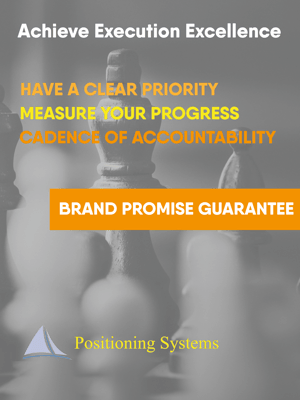 To build an enduring great organization you need disciplined people, engaged in disciplined thought, to take disciplined action, to produce superior results, making a distinctive impact in the world.
To build an enduring great organization you need disciplined people, engaged in disciplined thought, to take disciplined action, to produce superior results, making a distinctive impact in the world.
Discipline sustains momentum, over a long period of time, to lay the foundations for lasting endurance. It’s the framework for Good to Great:
- Stage 1: Disciplined People
- Stage 2: Disciplined Thought
- Stage 3: Disciplined Action
- Stage 4: Build Greatness
Positioning Systems is obsessively driven to elevate your teams Discipline. A winning habit starts with 3 Strategic Disciplines: Priority, Metrics and Meeting Rhythms. Your business dramatically improves forecasting, accountability, individual, and team performance.
.jpg?width=300&name=3%20Disciplines%20of%20Execution%20(Strategic%20Discipline).jpg) Creating Execution Excellence demands creating/defining, understanding, with creativity and DISCIPLINE your Flywheel.
Creating Execution Excellence demands creating/defining, understanding, with creativity and DISCIPLINE your Flywheel.
Meeting Rhythms achieve a disciplined focus on performance metrics to drive growth.
Positioning Systems helps your business achieve these outcomes on the Four most Important Decisions your business faces:
|
DECISION |
RESULT/OUTCOME |
|
PEOPLE |
|
|
STRATEGY |
|
|
EXECUTION |
|
|
CASH |
|
We help your business Achieve Execution Excellence.
Positioning Systems helps mid-sized ($5M - $250M) business Scale-UP. We align your business to focus on Your One Thing! Contact dwick@positioningsystems.com to Scale Up your business! Take our Four Decisions Needs Assessment to discover how your business measures against other Scaled Up companies. We’ll contact you.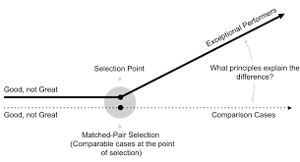
Next Blog: Map for the Journey from Good to Great
The Flywheel is one piece of the puzzle for building your business from Good to Great. Jim Collins' map for building a Good to Great company is our next blog.






.jpeg?width=150&height=135&name=Hand%20with%20marker%20writing%20the%20question%20Whats%20Next_%20(1).jpeg)

